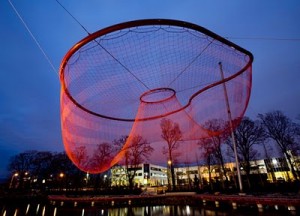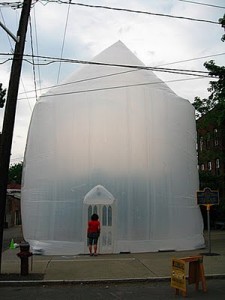On the final day of the conference, Saturday, Feb. 12, I began with the session, Textiles and Social Sculpture, chaired by Hazel Siegel from the Pratt Institute. Three of the four presentations were by artists about their own art and one was by art historian Julie Schlarman, of University of South Dakota, about the public art of Janet Echelman. Echelman creates monumental public sculptures out of high-density polyester fibers, which are frequently used by NASA or engineering companies. She uses traditional knotting techniques practiced by fisherman to fabricate her sculptures. Her public works react to the surrounding natural environment and sometimes include other architectural elements. In her sculpture, Water Sky Garden, created for the 2010 Vancouver Olympic Winter Games, the netted “sky lantern” hangs from a steel structure over a bridge of red painted cedar.

Following the presentation by Schlarman, artist Olivia Robinson presented Temporary Spaces for Resistant Histories. She discussed recent projects she and her group, “Spectres of Libery,” have pursued in communities in the Northeast. Robinson’s organization describes itself as “an on-going public, hybrid media project about the history of the movement to abolish slavery in the United States.” The projects she spoke about included The Great Central Depot in the Open City and Ghost of the Liberty Street Church. Both public pieces seek to make visible the history of hidden people and movements of resistance. Ghost of the Liberty Street Church recreated a demolished church out of inflatable, transparent fabric. In the 1840s, the church was the sight of historic gatherings fighting to abolish slavery under pastor Henry Highland Garnet. I was struck by the soft, almost delicate appearance of the structure as the backdrop for such serious discussions surrounding human civil rights.

Also presenting on the topic of Textiles and Social Sculpture was artist Elaine Reichek. She spoke about the 16 hand-embroidered samplers displayed in her digital exhibition, madamimadam, at the Isabella Stewart Gardner Museum. The research for this project was completed while Reichek was an artist-in-residence at the Isabella Stewart Gardner Museum, in February 2001. The final project was not a traditional exhibition, due to the Gardner Trust’s stipulation that the current display of work had to be permanent and could not to be altered except for purposes of maintenance or loan. To get around this rule, Reichek installed her work on easels, tables and empty spaces on the walls, while the museum was closed. The works were then photographed and, 10 years later, still live on in the original format of a digital exhibition.
After this session, I joined a room of artists, academics, curators and persons interested in craft for the Critical Craft Forum: Platform for Exchange. Co-chairs Namita Wiggers, Curator at the Museum of Contemporary Craft, and Elisabeth Agro, Curator at the Philadelphia Museum of Art, led a conversation about how to foster more critical dialogue around craft. After the 2010 CAA conference, many individuals expressed the need for a space to explore and discuss research, exhibitions, ideas and publications surrounding craft. Out of this meeting, the “Critical Craft Forum” was formed on Facebook. Since its initial founding, the group on Facebook has become stagnant. The co-chairs discussed possibly changing the forum from a Facebook group to that of a blog and inviting guest writers to create posts on different issues surrounding craft. A majority of the audience was receptive to this idea, with many of us signing up to volunteer and be part of the next steps of a “Critical Craft Forum.”
Overall, I was excited to attend my first CAA conference and find so many thought-provoking sessions that related to the field of craft. Historically, craft tried to prove itself to the “fine” art world and was frequently overlooked as an amateur art form. It was inspiring to participate in discussions and listen to presentations that are leaving that debate behind and looking ahead to articulate craft’s importance within its own field. Through the development of more research and critical dialogue, craft will become more widely represented in academia and articulate its own place in the field of the visual arts.
Anna Walker, Curatorial Fellow

